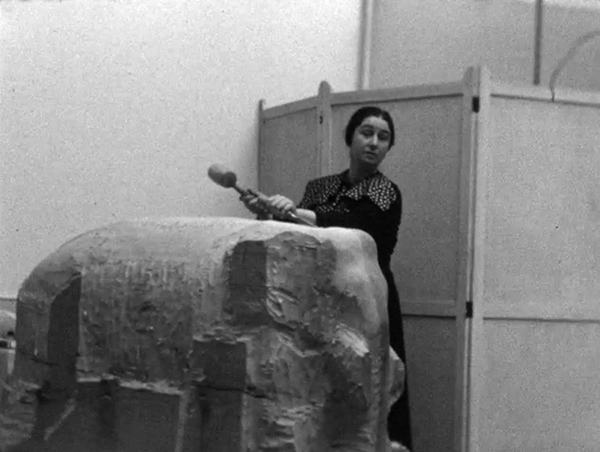Artist’s Spotlight: Cornelia Chapin
 |
|
Cornelia Chapin at work on her prize-winning sculpture Young Elephant.
|
For Women’s History Month the NFPF is calling attention to the home movies of Cornelia Van Auken Chapin (1893–1972), preserved through an NFPF grant by the Archives of American Art, a unit of the Smithsonian Institution
Cornelia Chapin was a sculptor who specialized in creating stone and wood sculptures of animals through the direct carving method, which favored sculpting directly from life, without the use of models or casts. Artists in this movement, which rose to prominence after 1915, believed in the “truth of materials”—that a finished work of art should display the inherent properties of the raw material it was sculpted from. Very little period footage of artists engaged in direct carving exists, and during this period there was more documentation of male than female sculptors—these factors make Chapin’s home movies even more valuable.
Chapin held her first exhibition as a sculptor in 1930; four years later she had moved to Paris to study as the only pupil of Mateo Hernandez, from whom she learned direct carving. In 1936 she became the only foreigner and woman sculptor elected to the Societaire Salon d'Automne in Paris. Renown and success further marked her career: She exhibited at the 1939–40 World's Fair in New York, the San Francisco Golden Gate Exposition in 1939, the Brooklyn Museum, the Philadelphia Museum, the Salon des Tuileries and many other venues. She was a member of the National Academy of Design, the National Sculpture Society, the New York City Art Commission, and the "Philadelphia Ten,” a group of female artists who trained and exhibited together in that city from 1917 to 1945.
Residents of the east coast might be familiar with Chapin’s sculpture without knowing it. Her Christ the King blesses the high altar at the Cathedral Church of St. John the Divine in New York, while Giant Frog is featured in Philadelphia’s Rittenhouse Square, and Paquita the Bear adorns the Smithsonian’s National Zoo in Washington, D.C.
The genesis of the last sculpture can be found in Chapin’s home movies, which document her years in Paris from 1934–36. Visiting the Paris Zoological Park and Jardin d’Acclimatation, Chapin is seen at her sculpture cart, carving directly from her observations of animals. In the studio Chapin is seen alongside Mateo Hernandez and working on her Young Elephant, winner of the Second Anna Hyatt Huntington Prize for sculpture at the National Association of Women Painters and Sculptors in 1936. The bear cub who goes on a tiny rampage through the studio is the future model of Paquita (1941).
An earlier home movie in the collection—titled Hilltop Happenings: Harpursville, Summer 1932—shows Chapin working on a sculpture of a female nude, doing chores, and socializing with friends in upstate New York. A friend identified by a title card as “Gen” is believed to be Genevieve Karr Hamlin, a fellow sculptor and member of the “Philadelphia Ten.” Hamlin and Chapin were later members of the all-female group, which originally consisted of ten painters and grew to include twenty more artists.
Chapin’s home movies were donated to the Archives of American Art by her close companion and artistic partner Marion Sanford, as part of the couple’s papers. The films were in a critical state of deterioration and required preservation, which was funded by the NFPF and supervised by AAA archivist Megan McShea. Chapin’s home movies, now freely available to the public, provide a rare look into the lives of female artists during the 1930s, and shows them creating work that still merits greater attention.
